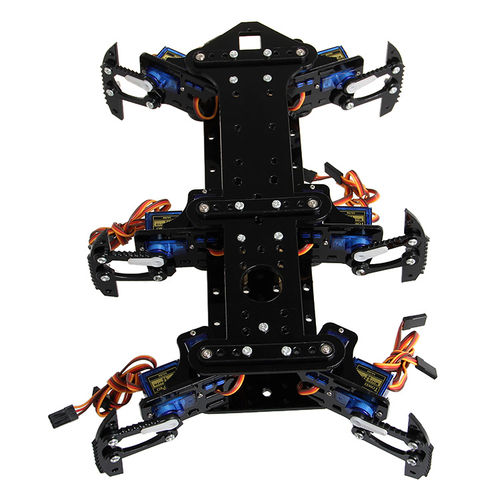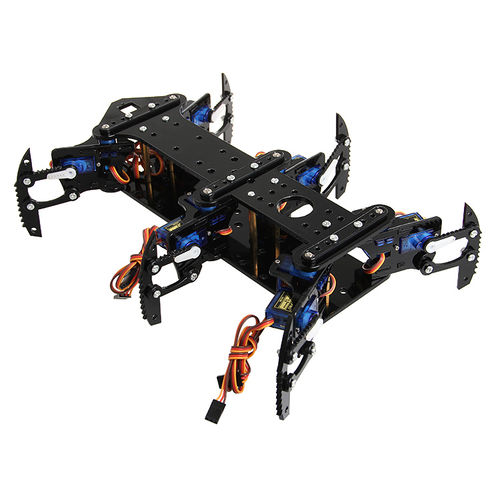Hexapod robot
Contents
hexapod robot
A hexapod robot is a mechanical vehicle that walks on six legs. Since a robot can be statically stable on three or more legs, a hexapod robot has a great deal of flexibility in how it can move. If legs become disabled, the robot may still be able to walk. Furthermore, not all of the robot's legs are needed for stability; other legs are free to reach new foot placements or manipulate a payload.
Many hexapod robots are biologically inspired by Hexapoda locomotion. Hexapods may be used to test biological theories about insect locomotion, motor control, and neurobiology.
Designs
Hexapod designs vary in leg arrangement. Insect-inspired robots are typically laterally symmetric, such as the RiSE robot at Carnegie Mellon.A radially symmetric hexapod is ATHLETE (All-Terrain Hex-Legged Extra-Terrestrial Explorer) robot at JPL.
Typically, individual legs range from two to six degrees of freedom. Hexapod feet are typically pointed, but can also be tipped with adhesive material to help climb walls or wheels so the robot can drive quickly when the ground is flat.
Locomotion
Most often, hexapods are controlled by gaits, which allow the robot to move forward, turn, and perhaps side-step. Some of the most common gaits are as follows:
Alternating tripod: 3 legs on the ground at a time.
- Quadruped.
- Crawl: move just one leg at a time.
- Gaits for hexapods are often stable, even in slightly rocky and uneven terrain.
Motion may also be nongaited, which means the sequence of leg motions is not fixed, but rather chosen by the computer in response to the sensed environment. This may be most helpful in very rocky terrain, but existing techniques for motion planning are computationally expensive.
Types of locomotion
- Wheeled
In terms of energy efficiency on flat surfaces, wheeled robots are the most efficient. This is due to the fact that an ideal rolling (but not slipping) wheel loses no energy. A wheel rolling at a given velocity needs no input to maintain its motion. This is in contrast to legged robots which suffer an impact with the ground at heelstrike and lose energy as a result.
There are many different types of wheeled robots, the most common being the Reed Shepps type and the unicycle type. The major concern in the motion planning of wheeled robots are the holonomic constraints that the robot is subject to. These are decided by the type of wheels, number of wheels and the direction of the axes of rotation of the wheels.
- Examples
iRobot's Roomba
- Walking
Biologically inspired
Insects are chosen as models because their nervous system are simpler than other animal species. Also, complex behaviours can be attributed to just a few neurons and the pathway between sensory input and motor output is relatively shorter. Insects' walking behaviour and neural architecture are used to improve robot locomotion. Alternatively, biologists can use hexapod robots for testing different hypotheses.
Biologically inspired hexapod robots largely depend on the insect species used as a model. The cockroach and the stick insect are the two most commonly used insect species; both have been ethologically and neurophysiologically extensively studied. At present no complete nervous system is known, therefore, models usually combine different insect models, including those of other insects.
Insect gaits are usually obtained by two approaches: the centralized and the decentralized control architectures. Centralized controllers directly specify transitions of all legs, whereas in decentralized architectures, six nodes (legs) are connected in a parallel network; gaits arise by the interaction between neighbouring legs.
Hexypider
Hexypider is a mechanical articulated kit to make a hexapod robot. it contains the main body and six legs, and other fitting parts. All parts are made of high –quality, laser-cut acrylic plate, simple but strong enough to payload 18x 9g servos, and controller board and battery.
Typically, individual legs range from two to six DOF (degrees of freedom). Each leg of this hexapod robot has 2 joints (2 DOF): the thoraco - coxal (TC-) joint enables forward and backward movements, the coxa-trochanteral (CTr-) joint enables elevation and depression of the leg, giving it high mobility to walk flexibly.
Features
Acrylic structure, light and solid
6 Legs with 2 Servos for each
Easy and Quick Assembly
High mobility
Suitable for students and adults alike
Specs
Dimension: 9 x 20 x 8.5 cm (L x B x H)
Weight: 157g
Material: Imported high-quality laser cutting acrylic
6 Legs with 2 degrees of freedom of each leg
Active tail rotating in horizontal and vertical axis
Compatible with 18 x 9g servos
Backbone joint rotating in a horizontal axis
Assembly
Here you can download the Assembly manual of hexypider.
List of robots
Autonomous walking machine AMOS
where to get
here you can get a kit for a hexapod

